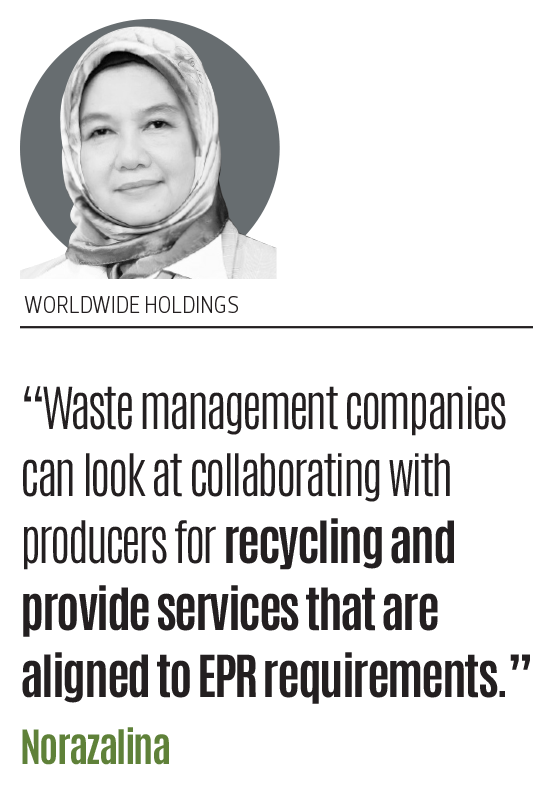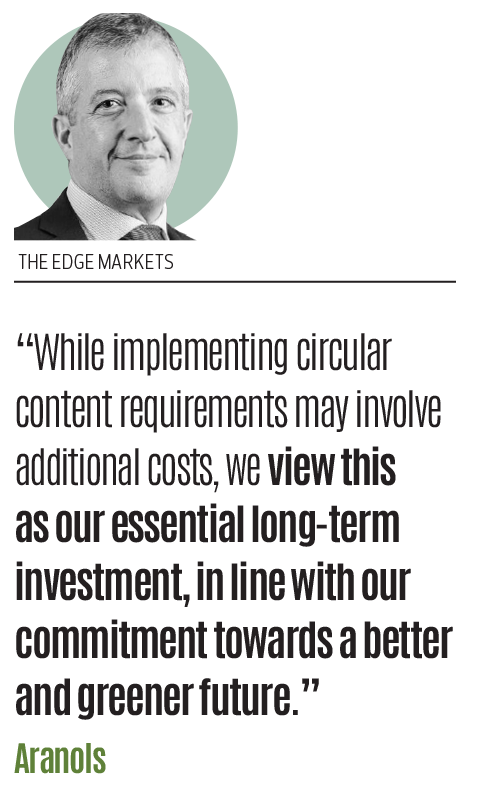This article first appeared in The Edge Malaysia Weekly on December 30, 2024 - January 12, 2025
Malaysia has a longstanding issue of ballooning amounts of plastic waste. Some parties argue that one of the ways to address this issue is to make polluters responsible, and this has given support to the concept of extended producer responsibility (EPR).
In fact, EPR is a key policy approach in the Circular Economy Policy Framework for the manufacturing sector launched by the Ministry of Investment, Trade and Industry (Miti) in September. A circular economy blueprint for the waste sector was also introduced in August. In general terms, the circular economy concept advocates zero waste.
With the country’s recycling rate at just over 35% as at 2023, there are hopes that an EPR system will drastically minimise the amount of plastic and other recyclable waste entering its landfills and environment.
ESG speaks to industry players from the manufacturing and waste management sectors, and the Consumer’s Association Penang on the matter.
A call for conscious disposal
To tackle issues related to domestic waste segregation, collection and recycling, the Ministry of Housing and Local Government (KPKT) introduced the Blueprint Ekonomi Kitaran bagi Sisa Pepejal (2025–2035) in August.
The blueprint outlines several long-term plans to promote a circular economy by improving waste segregation and collection, integrating advanced recycling technologies and ensuring materials remain in the circular cycle. The ultimate goal is to achieve zero waste to landfill.
“While the EPR framework may reduce the reliance on traditional disposal methods, it also provides a platform for waste management companies to enhance their role within the value chain, transitioning from a mere disposal provider to a strategic partner in sustainable resource management,” says Datin Paduka Norazlina Zakaria, CEO of environmental management services provider Worldwide Holdings Bhd and executive director of Worldwide Entech Sdn Bhd.
Norazalina observes that this shift is anticipated to reduce the volume of mixed waste going to waste disposal companies.
“It may contribute to a positive implication to waste businesses as demand for specialised recycling will increase. Hence, waste management companies can look at collaborating with producers for recycling and provide services that are aligned to EPR requirements,” she adds.
At the disposal end, she says there will be a potential reduction of feedstock for waste to energy (WTE) or disposal at landfill sites due to these increased recycling mandates.
“Despite the reduced feedstock, the shift brings benefits, particularly given the limited WTE capacity and the scarcity of land in Selangor,” Norazalina says.
When the minimum circular content is introduced, she says, it wil be beneficial for disposal companies to sort out waste as it will be easily recognised and segregated as recyclable and non-recyclable.
For instance, it opens up opportunities for collaboration with manufacturers to ensure that only true residual waste ends up in WTE or landfills.
“As recycling is the main focus, it may result in a higher proportion of non-recyclable materials being sent to our landfill or WTE sites. Given this scenario, we will see this as an opportunity to optimise our WTE operations to ensure efficient energy recovery from non-recyclable materials,” she says.
Short-term cost dilemma
The Circular Economy Policy Framework encourages manufacturers and producers to shift from the traditional linear approach of reduce, reuse and recycle to a more comprehensive circular economy model. This new model prioritises minimising waste, maximising resource efficiency and restoring natural systems.
For instance, companies such as Nestlé (Malaysia) Bhd (KL:NESTLE) and Mondelez International Inc, which are part of the Malaysian Recycling Alliance (Marea), collaborate with the government and other stakeholders to jointly improve collection and recycling rates for a cleaner, more sustainable and waste-reduced future.
“We are working at both ends, which is actively engaging stakeholders to minimise plastic waste, as well as taking action to reduce virgin plastic consumption, ensuring that it is recyclable and adopting better alternatives to plastic as they become available at scale. We have eliminated over 200 million plastic straws per year by adopting paper straws from sustainably certified sources. We have also eliminated virgin plastic in our ‘Ready to Drink’ products and our Milo and Nescafe bottles are made with 100% recycled polyethylene terephthalate,” says Nestlé CEO Juan Aranols.
Nestlé, which is a founding member of Marea, has been voluntarily implementing EPR through initiatives like Project Save. This project focuses on managing post-consumer waste, promoting plastic neutrality and advancing the circular economy.
Aranols says this is done in collaboration with KPT Recycle and municipalities across Selangor to organise the collection and separation of waste at source, recycling and creating physical infrastructure.
Similarly, Mondelez finds EPR as another avenue to ensure producers and manufacturers commit to taking responsibility for the entire product life cycle.
“We have already made strides by evolving our portfolio to include recycle-ready packaging in Malaysia, with 98% of our packaging across Southeast Asia now designed to be recyclable,” says Narmeen Khan, managing director of Malaysia and Singapore at Mondelz.
Beyond packaging, the company also contributes to supporting infrastructure development for plastic waste collection, sorting and recycling. This includes collaborating with industry coalitions and public-private partnerships, where it commits to recycling at least 25% of plastic packaging volumes by 2025.
Currently, the company has committed to ensuring that 98% or more of its packaging will be recyclable by 2025 and contain 5% recycled plastic to fulfil the minimum circular content.
Both fast-moving consumer goods (FMCG) companies say costs may increase to comply with the initiative of the minimum percentage of circular or recycled materials in packaging, electrical and electronics (E&E) and consumer goods.
“While implementing circular content requirements may involve additional costs, we view this as our essential long-term investment, in line with our commitment towards a better and greener future,” says Aranols.
He observes that costs tend to be higher compared with traditional plastic solutions, and many manufacturers are still very hesitant about adopting some of these solutions as they are concerned about the short-term cost impacts.
“Nestlé would like to demonstrate that these solutions are feasible and then encourage others to follow suit to create the necessary economies of scale that will allow us to reduce costs over time,” he says.
The minimum circular content initiative outlined in the Circular Economy Policy Framework aims to increase the usage of circular materials through the adoption of circular content in products. It will also reduce the volume of waste, which ends up in landfills, and increase resource productivity by reducing reliance on virgin raw materials.
The European Union (EU) provides a relevant example of such initiatives, with clear targets and implementation strategies for minimum recycled content requirements outlined in Directive (EU) 2019/904. This directive mandates that single-use plastics include at least 25% recycled content by 2025, to be increased to 30% by 2030.
Protecting consumers
From the consumers’ perspective, the implementation of EPR may affect the prices of goods and services. Since EPR shifts the financial burden of waste management from the public sector to producers, companies may pass some of these costs on to consumers.
This could lead to higher prices for goods as costs related to redesigning products, sustainable packaging, recycling and compliance with EPR policies could be reflected in product prices, says Mohideen Abdul Kader, president of the Consumers’ Association of Penang.
While the EPR is currently voluntary and recycling costs are absorbed by manufacturers or producers, the long-term implications of a mandatory EPR system might allow costs to trickle down to consumers as well.
“Price increases for everyday goods, especially FMCGs like food and household items, disproportionately affect low-income groups who spend a larger share of their income on basic needs,” he says.
“Companies might limit the production of low-margin goods or reduce offerings in cost-sensitive markets, limiting options for low-income consumers. We are worried that taxes or fees associated with EPR, such as those funding recycling programmes, might indirectly affect all consumers equally, regardless of income, amplifying regressive financial impacts.”
While introducing mandatory EPR poses benefits, Mohideen notes that EPR should be aligned with zero waste principles, promoting product longevity, reusability, repairability and recyclability from the design stage itself.
Additionally, he says, an ideal circular economy can only be achieved by shifting focus away from harmful projects like WTE incineration and instead emphasising core strategies like waste reduction, composting, recycling, reusing, refilling and repairing.
“Strengthening green finance mechanisms and supporting research and development in safe, non-toxic recycling technologies also can drive innovation and make circular economy practices more accessible and scalable.”
Save by subscribing to us for
your print and/or
digital copy.
P/S: The Edge is also available on
Apple's App Store and
Android's Google Play.



